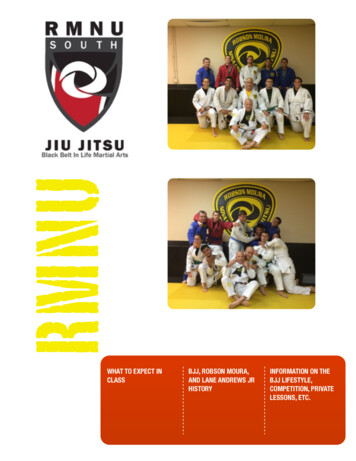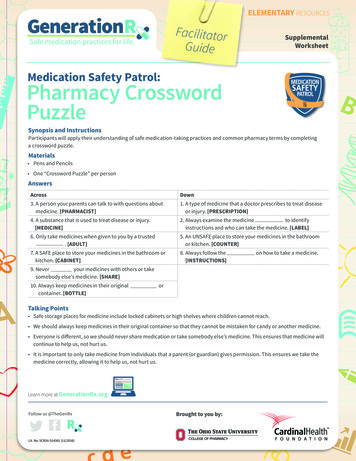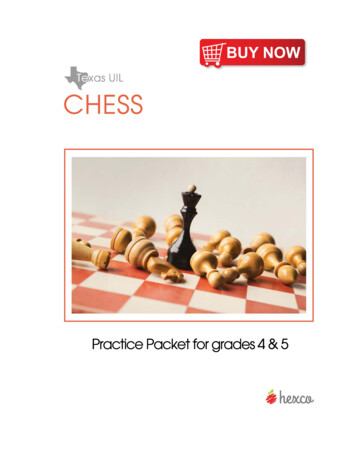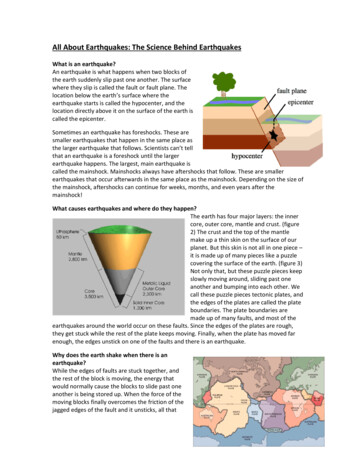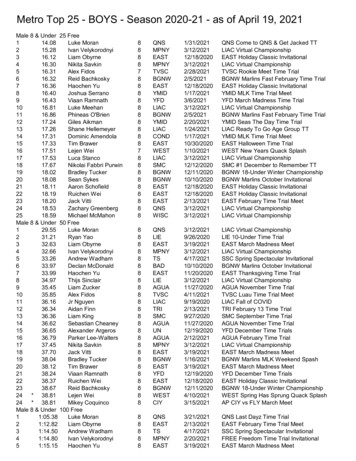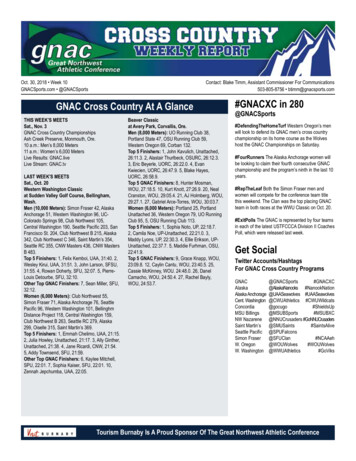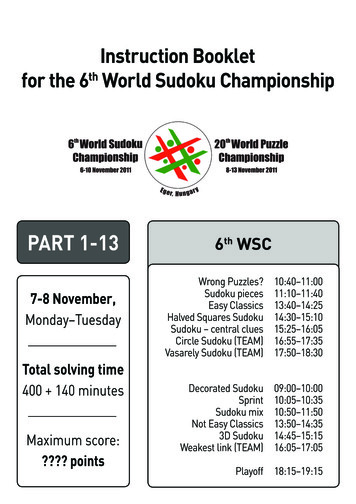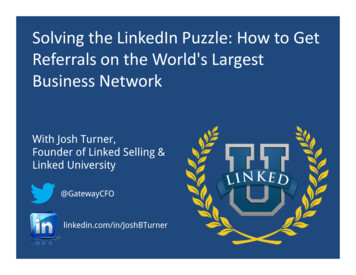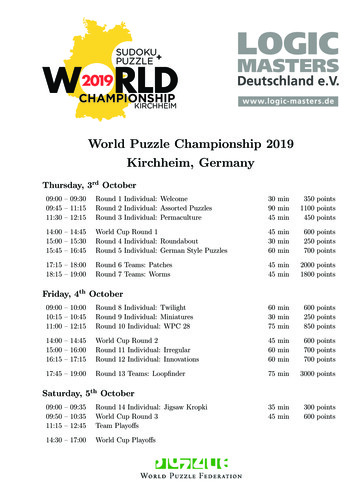
Transcription
SUDOKUPUZZLE CHAMPIONSHIPKIRCHHEIMWorld Puzzle Championship 2019Kirchheim, GermanyThursday, 3rd October09:00 – 09:3009:45 – 11:1511:30 – 12:15Round 1 Individual: WelcomeRound 2 Individual: Assorted PuzzlesRound 3 Individual: Permaculture30 min90 min45 min350 points1100 points450 points14:00 – 14:4515:00 – 15:3015:45 – 16:45World Cup Round 1Round 4 Individual: RoundaboutRound 5 Individual: German Style Puzzles45 min30 min60 min600 points250 points700 points17:15 – 18:0018:15 – 19:00Round 6 Teams: PatchesRound 7 Teams: Worms45 min45 min2000 points1800 pointsFriday, 4th October09:00 – 10:0010:15 – 10:4511:00 – 12:15Round 8 Individual: TwilightRound 9 Individual: MiniaturesRound 10 Individual: WPC 2860 min30 min75 min600 points250 points850 points14:00 – 14:4515:00 – 16:0016:15 – 17:15World Cup Round 2Round 11 Individual: IrregularRound 12 Individual: Innovations45 min60 min60 min600 points700 points700 points17:45 – 19:00Round 13 Teams: Loopfinder75 min3000 points35 min45 min300 points600 pointsSaturday, 5th October09:00 – 09:3509:50 – 10:3511:15 – 12:45Round 14 Individual: Jigsaw KropkiWorld Cup Round 3Team Playoffs14:30 – 17:00World Cup Playoffs
Competition RulesScoring and BonusesPoints will be awarded only for fully and correctly solved puzzles. In general, there is no partial credit unless statedotherwise in the round’s description.Individual RoundsA bonus of 10 points for each full remaining minute will be awarded to any competitor who correctly solves allpuzzles in a round. A partial 60% bonus can be awarded if one puzzle is incorrectly solved, under the conditionthat the puzzle is solved completely or almost completely and the competitor may have believed their solution tobe correct. In case of doubt, the decision will be made in favour of the competitor; the decision of the judges isfinal.Team RoundsA bonus of 50 points for each full remaining minute will be awarded to any team who correctly solves all the puzzlesin a round. If there are any mistakes, then no bonus will be awarded.Competition Hall Rules1. All competitors have to sit at their pre-allocated desk in individual rounds. Teams have to work at theirpre-allocated desk area for team rounds.2. Prior to the start of each round, competitors must ensure they are at their desks ready for the start of theround. Late arrivals may not be permitted to enter the competition hall to take part in a round (at the discretionof the organizers).3. Prior to the start of each round, competitors have to clearly write their name, team and reference number onthe front page of their competition booklet into the allocated space. If this information is not complete, then theorganizers reserve the right not to award any points to that competitor for that round. Competitors must not opentheir booklets before the official start of the round.4. When the signal for the start of the round has been given, competitors may open their booklets and beginsolving the puzzles.5. During each individual round, competitors have to keep silent, unless declaring completion of a round.6. During team rounds, team members may talk to each other, but should do this with respect to other teams.7. To declare a round complete, a competitor must close their booklet, clearly state “finished” and raise their armwith the booklet. The competitor’s arm must be raised until the booklet is collected. The same rules apply for theteam competition.8. Competitors or teams who complete a round with more than five minutes in advance, are allowed to leave thecompetition hall quietly.9. Competitors or teams who complete a round with five minutes or less left are not allowed to leave their desksor tables in order to cause no unnecessary disruption to fellow competitors.10. When a competitor leaves the competition hall for any reason, they may not be allowed to continue in thatround (at the discretion of the organizers).11. When the signal is given that the round is finished, competitors have to stop solving immediately, close theirbooklets, put their pens or pencils down and their hands up with their booklets for collecting.12. At the end of a round, competitors have to remain seated until all booklets have been collected. The signal toget up and leave will be given by the supervisor.13. Mobile phones and electronic devices are not permitted to use in the competition hall. The devices have to beturned off and must not be placed on the competitor’s desk.14. Only team captains and official observers equipped with a name tag are allowed to enter the competitionhall while either individual or team rounds are taking place. Other non-competing participants may enter thecompetition hall at the discretion of the organizers.15. Competitors may not use cameras or other recording devices during rounds. Only official observers may do so,at the discretion of the organizers. They have to respect the competitors and not use flash photography or cameraswith excessive sounds.16. When a competitor believes that there is a problem with a puzzle, they must clearly state that puzzle is wrongby writing “Wrong puzzle” next to it. The competitor must not notify the organizers during the round. This willbe investigated upon completion of the round.2
17. Puzzles can be completed in any order within a round. The points’ value of a puzzle is an indication of itsexpected difficulty, although individual solving experience may differ. The difficulty of an example puzzle does notnecessarily reflect the difficulty of the corresponding competition puzzle.Permitted items18 Permitted items which can be used in the competition hall (unless stated otherwise) are: pens, pencils, pencilsharpeners, erasers, rulers, blank papers and instruction booklets annotated with notes regarding puzzle instructionsand preparation notes.19. Drinks and snacks are permitted as long as they do not disturb other competitors with a strong smell orrustling packet.20. It is strictly forbidden to use electronic devices such as music players and headphones or any type of calculator.Use of such equipment may lead to the disqualification of the competitor.21. Any other items brought into the hall must be kept in a bag on the floor and placed under the competitor’sdesk, so as not to block the aisles.Marking and Queries22. When a round has been evaluated, fully marked booklets are returned to a team member equipped with acountry tag at a given location in a given time. Country tags will be distributed to each captain prior the start ofthe championships.23. In case of any query after a booklet has been evaluated and returned to a competitor, the query must be raisedthrough a team member with country tag to the organizers in the specified time. The schedule for the queries willbe published before the competition. The booklet should be left with the organizers for investigation.24. Puzzles may be photographed during the marking phase in order to prevent subsequent interventions.25. Team captains are responsible for ensuring that any information given to them related to the competition iseffectively relayed to their team.Breach of Rules26. Any breach of these rules may lead to penalty points, or in severe cases to a competitor or team beingdisqualified from the round or competition.27. The decision of the WPC tournament director (Ulrich Voigt) is final.Final Remarks28. In case of a major mistake in one of the rounds, organizers reserve the right to cancel the round, either byremoving it from the time schedule, or by not awarding any points for it to any of the competitors.29. The official puzzle booklets will contain one or multiple puzzles per page in the individual rounds. The rulesof the puzzle and the corresponding points are always written next to it.30. The official puzzle booklets will not contain puzzle examples. Therefore, we recommend to bring the InstructionBooklet, which contains an example of every puzzle which will be part of the championship.31. In the team rounds, the official puzzle booklets may contain neither puzzle rules nor examples. It is advised tobring at least one Instruction Booklet for a team for these rounds.32. In any case of inconsistency between this Instruction Booklet and the official puzzle booklets, e.g. rules orpoints, the information in the Instruction Booklet will be considered valid.33. In the competition hall, a timer counting down to the end of the round will be visible for all the competitors.Puzzle CreditsAuthors will remain anonymous individually until the solutions are distributed. The organisers would like to collectively thank Silke Berendes, Rainer Biegler, Jürgen Blume-Nienhaus, Christian Halberstadt, Sebastian Matschke,Erhard Notz, Gabi Penn-Karras, Christoph Seeliger, Roland Voigt, Ulrich Voigt and the World Puzzle Federationfor the example and competition puzzles.3
World Puzzle Championship and Puzzle World CupThis year’s competition will hold two separate tournaments, namely the World Puzzle Championship and thePuzzle World Cup.World Puzzle ChampionshipThe World Puzzle Championship is the main competition, very similar to previous WPCs. It consists of 11individual rounds and 3 team rounds. The individual ranking will be determined by the sum of the scores of allindividual rounds; there are no individual playoffs. The competitor with the highest total score will be declaredWorld Puzzle Champion. In case of a tie in the top 3, one single tiebreaker puzzle will determine the final ranking.Details will be announced when the situation arises. In case of a tie outside the top 3, all competitors with thesame total score will share the same rank.The team ranking will be determined by the sum of the individual scores of the four team members, plus the scoresof the team rounds. The four teams with the highest total scores will qualify for the team playoffs. In case of atie, all teams tied for fourth place will qualify for the team playoffs.Team PlayoffsTeams will start the playoff with time offsets based on the preliminary results, according to the following formula:Time offset (Score difference / 10) secondsHowever, if this formula would lead to a time offset of more than 7 minutes, the time offset for the team in 4thplace will be set at 7 minutes and the time offsets for the other teams will be calculated proportionally accordingto their score differences.The team playoffs will consist of an individual part and a team part. In the individual part, there are four setsof two puzzles. Each team member must solve one of these sets individually. The distribution of these sets to theteam members is part of the team strategy. Within each set, there is no defined order of the puzzles.When a competitor solves the first puzzle of their set, they hand the solved puzzle to a judge and continue withthe second puzzle. If the solution is correct, they will be briefly notified. If the solution is incorrect, the judge willreturn the incorrect puzzle to the competitor who can decide for themselves which puzzle to continue first.When a competitor solves the second puzzle of their set, they hand their solved puzzle to a judge to enter thesubmission period. The entire solution will then be checked over the next minute. If the solution is incorrect,the judge will return the incorrect puzzle to the competitor. The competitor can resubmit a returned puzzle atany time, and will again enter the submission period. If the solution is correct and thus both puzzles are solvedcorrectly, the competitor advances to the team table.A competitor solving the individual puzzles may, at any time, ask for assistance from team mates who have alreadyadvanced to the team table. Any competitor who already advanced to the team table may decide to help one oftheir team members and join them at their individual table. However, when they decide to do so, they must remainat this individual table until both puzzles are solved correctly. Multiple team members may give assistance, butwith the same restriction. Team members may communicate with each other to decide their team strategy.The team part consists of four puzzles. Competitors who advance to the team table can start solving, however thepuzzles cannot be solved completely unless all four team members have arrived at the team table. Teams can solvethese puzzles in any order they like, however they can only work on one puzzle at a time. When a team finishesa puzzle, they notify the judges to enter the submission period. The entire solution will then be checked over thenext minute. After one minute, if the solution is correct, the team continues with the next puzzle. If the solutionis incorrect, the judges return the puzzle to the team. Teams can resubmit a returned puzzle at any time, and willagain enter the submission period.The team who finishes all four team puzzles first is declared winner. The team playoffs end when three teamsfinish. If this has not happened after 90 minutes, the playoffs will be aborted; the final ranking is determinedby (a) number of correctly solved puzzles, (b) time of the last correct submission, (c) total team score of thepreliminary rounds.Puzzle World CupThe Puzzle World Cup is a new knockout tournament, completely independent from the World Puzzle Championship, and replaces the individual playoffs from previous years. It starts with three regular puzzle rounds. In thefirst round, anyone can compete. After the first round, the top 100 competitors advance to round 2. The secondand third round are similar, with 40 respective 16 competitors advancing. For the ranking in each round only thescores of the current round are considered, results of earlier rounds are not counted.For competitors who solve all puzzles with time to spare, the same bonus rules as in the World Puzzle Championshipapply.In case of a tie after round 1 or round 2, anyone tied for 100th or 40th place will advance to the next round. Forround 3 the situation is different: If there is a tie for 16th place, the competitors who scored better in round 2 will4
advance, and if that fails to distinguish, the competitors who scored better in round 1 will advance. If there is stilla tie after that, a single tiebreaker puzzle will decide who advances; details will be announced when the situationarises.Note: Competitors who have been eliminated in an earlier round may still join the later rounds and solve thepuzzles; their booklets will not be graded though. All three World Cup rounds are not counted towards the WorldPuzzle Championship.Individual PlayoffsThe 16 competitors who advanced from round 3 will determine the winner via individual playoffs. The competitorswill be drawn into four semifinals of four players, the winner of each semifinal advances to the final. There will beno carry-over, in each semifinal all four players start at the same time.For these playoffs, a puzzle pool with 35 puzzles will be used. Before each semifinal five puzzles are drawn. Thesepuzzles have to be solved in order; the first competitor to solve all puzzles correctly advances to the final. Nopuzzle will be used for more than one playoff round. A list of puzzle types will be provided during the WPC.When a play-off competitor completes a puzzle, they hand their solved puzzle to a judge to enter the submissionperiod. The entire solution will then be checked over the next minute. After one minute, if the solution is correct,the judge will allow the competitor to begin the next puzzle. If the solution is incorrect, the judge will return theincorrect puzzle to the competitor. The competitor can resubmit a returned puzzle at any time, and will againenter the submission period.When one competitor has solved all puzzles correctly, they advance to the final, and the semifinal ends. If this hasnot happened after 35 minutes, the semifinal is aborted. In this case, the winner of the semifinal is determinedby (a) number of correctly solved puzzles, (b) time of the last correct submission, (c) total score of the threepreliminary World Cup rounds. If the abort happens while a competitor is in their submission period and thesubmitted solution is correct, the solved puzzle is counted for the ranking.The final will be conducted in the same way as the semifinals. Again, five puzzles are drawn, and the first competitorto solve all puzzles correctly is declared the winner of the Puzzle World Cup. The only difference is that the finaldoes not end after the winner is determined, but after either three competitors have finished or 35 minutes haveelapsed. If the final is aborted after 35 minutes, the final ranking is determined by (a) number of correctly solvedpuzzles, (b) time of the last correct submission, (c) total score of the three preliminary World Cup rounds.NotationThe participants are allowed to use different notations, as long as it is clear how the chosen notation translatesinto the given task.Examples: In dissection puzzles, it is allowed to draw the connecting lines between all cells belonging to the same region.Isolated cells which do not have any connecting lines are considered regions of size 1. Note, however, that ifthere are adjacent cells without any connecting lines remaining, the dissection and thus the solution will beconsidered as incomplete. If the solution is intended to have adjacent one-cell regions, they must at least bemarked as such by small dots/circles or similar, denoting the absence of connections. In shading puzzles it is allowed to instead mark the respective cells with symbols, such as X’s. If, for example,the shaded cells form an area (as in Tapa or Nurikabe), it is also allowed to draw the connecting lines spanningthe entire shaded area. Conversely, in path/loop puzzles through grid cells it is allowed to shade or otherwise mark the cells spanningthe loop – but only as long as the pathway remains unique! This means, in puzzles where the path/loop isallowed to touch itself in a manner consistent with pathways, marking the cells is not considered sufficient,even if it turns out there would be only one pathway satisfying the global puzzle rules.If the task is to fill all grid cells (e.g. with symbols as in Latin Squares, but also with symbols and shading as inJapanese Sums, Magnets and the like), cells cannot remain empty. Empty cells will not automatically be consideredas shaded; the solution will be considered incomplete.Whatever notation is used, it has to be used consistently throughout the solution! In a dissection puzzle, forexample, a solution which uses connecting lines in half the grid and boundaries in another half is typically notconsidered valid; if two different complete notations are used throughout the grid, the solution will typically onlybe considered correct only if both notations display the same solution.All this is at the judge’s discretion.5
Puzzle GlossaryThe terminology in the puzzle instructions is generally used in the following sense, unless the rules of a particularpuzzle specifically say otherwise.Adjacent Cells: Two cells are said to be adjacent if they share an edge. For example, in a square cell grid, twocells are adjacent if and only if they lie horizontally or vertically next to each other.Touching / Neighbouring Cells: Two cells are said to be touching or neighbouring if they share at least apoint. Adjacent cells are automatically touching.Connected: A group of cells is said to be (inter)connected if for every pair of cells it is possible to find a pathconnecting the two cells which lies completely within the group, and which only travels from one cell to an adjacentcell in each step.This group of shaded cells is connected. If thecell marked “A” is removed, the group is nolonger connected.ARegion: A region is a set of connected grid cells, which is typically marked by drawing the borders of the regionbold (or sometimes by shading all the cells in the region). Regions may have holes, unless otherwise noted.In some puzzle styles the task is to divide the given grid into regions, in others the dissection is already given.Also, sometimes the task is to place certain regions in the grid, but without using all the grid cells.Shape: A shape is essentially a region for a dissection or placement puzzle; the term “shape” is typically usedinstead of “region” when the set of shapes that must be used is already given, as in Tetromino/Pentomino puzzlestyles. Note that, in such puzzles, the rules state whether rotating or reflecting the given shapes is allowed.Area / Size: The area or size of a region/shape is the number of cells that belong to it. Potential holes are notcounted here.Congruent: Two regions are said to be congruent if it is possible to find a sequence of movements (shifting,rotating and possibly reflecting) that transforms one of the regions exactly into the other. As a consequence, twocongruent regions must always consist of the same number of cells. For example, there are exactly 5 differenttetromino shapes and 12 pentomino shapes.Pentomino: A pentomino is a shape consisting of five connected cells in a square grid. There are twelve differentpentominoes:ILNILN NP PFILNP PTUFILNPTU U UFFFLITTUYVWVW WV V VTXY YZZX X XYZXYZW WZPentominoes are labelled with the letters shown here. In some puzzles these letters have actual meaning, usuallywhen some letters are marked in the puzzle grid and the respective pentominoes must be placed there.Similarly, there are five tetrominoes (seven, if reflected shapes are considered different) and 35 hexominoes, consisting of four respectively six connected cells in a square grid.Object Placement: There are various puzzles where the task is to place certain objects in the grid (often thesize of one cell, like stars, sometimes larger ones). The rules regarding the location of these objects – in particularthe possibility of touching – always refers to the underlying cells containing these objects in the solution, even ifthe graphics appear to leave a space between the objects and the cell boundaries.6
Dissection: There are various puzzles where the task is to divide the grid into regions. Unless otherwise noted,the dissection must take place along the grid lines, and every cell must belong to exactly one region (i.e. therecannot be either overlaps or leftovers).Drawing Lines: There are various puzzles where the task is to draw lines in the grid (loops, connections, etc).In some puzzles styles like Slitherlink, these lines must run along grid lines; in other puzzle styles like Masyu, theyrun through grid cells.In puzzles where lines through grid cells are to be drawn, it is customary to always draw them through the centerpoints of the respective cells. This means, for example, that a loop passing through a cell more than once willalways hit itself (even though it would theoretically be possible to draw the lines such that they pass throughdifferent parts of a cell without touching itself). If there is a rule that no cell can be used more than once, this willthen automatically imply that the lines cannot hit each other (or that the loop cannot hit itself).These two path segments use the same cell,which is usually not allowed.Loop: A loop is a closed and connected set of line segments, i.e. there are no open ends, and there cannot be twoor more separate loop components. Note that the connection requirement is stronger than that of the underlyingcells being connected.Snake: A snake is a single path in the grid which travels through adjacent cells only. Snakes often use a specialnotation, such as shaded cells or circles with number sequences instead of line segments, although this is not alwaysrelevant for the respective puzzle style.Snakes are not allowed to “touch” themselves. This means, if two adjacent cells are used by the snake, theunderlying snake path must directly connect the one cell with the other; if two (diagonally) touching cells areused by the snake, the underlying path must connect the two cells via adjacent cells without a detour. The samenon-touching condition is also sometimes used for loops (e.g. Bosnian Road).Both paths touch themselves.Length: The word “length” (for example of paths or contiguous cell groups) is not used with the same uniformmeaning throughout the instruction booklet. Sometimes – typically in shading puzzles, as in Coral – the termrefers to the number of cells; sometimes – typically in loop/path puzzles, as in Castle Wall – it refers to the numberof steps from one end to the other, i.e. the number of cells minus one. Read the specific puzzle instructions (andcheck the example) to find out which one is the case.Knapp Daneben: “Knapp Daneben” is the name of a variant that applies to many puzzle types involvingnumbers. It means that all given clues are off by exactly 1, i.e. the correct clue would be 1 higher or 1 lower thanthe number given in its place.Coded: “Coded” is the name of a variant that applies to many puzzle types involving numbers. It means that thenumbers have been replaced by symbols (typically letters); the substitution is such that same symbols correspondto same numbers, different symbols correspond to different numbers.Note, however, that sometimes the substitution refers to single digits only, and sometimes it refers to multi-digitnumbers – read the specific puzzle instructions to find out which one is the case.Incomplete Information: In many puzzles the potential position of clues is fixed, for example outside the gridor in certain marked cells. If such a position does not contain a clue, this means that the respective information isnot given (rather than take the value 0).Puzzle sizes: The instructions (for example “Enter numbers from 1 to 6 . . . ) always refer to the size of thecompetition puzzles. The examples often use smaller grids, smaller sets of shapes etc. Usually this should beobvious; in some cases when this may not be the case we have explicitly mentioned a different size.7
Round 1 Individual: Welcome30 minutes – 350 points1.1 Easy as Word Snake . . . . . . . . . . . . . . . . . . . . . . . . . . . . . . . . . . . . . 35 points1.2 ABCtje . . . . . . . . . . . . . . . . . . . . . . . . . . . . . . . . . . . . . . . . . . . . . . . . . . 50 points1.3 Alphametic . . . . . . . . . . . . . . . . . . . . . . . . . . . . . . . . . . . . . . . . . . . . . . 30 points1.4 Crossword . . . . . . . . . . . . . . . . . . . . . . . . . . . . . . . . . . . . . . . . . . . . . . . 55 points1.5 Coded Fillomino . . . . . . . . . . . . . . . . . . . . . . . . . . . . . . . . . . . . . . . . . 25 points1.6 Masterword . . . . . . . . . . . . . . . . . . . . . . . . . . . . . . . . . . . . . . . . . . . . . . 40 points1.7 Word Search . . . . . . . . . . . . . . . . . . . . . . . . . . . . . . . . . . . . . . . . . . . . . 20 points1.8 Tangled Words 1 . . . . . . . . . . . . . . . . . . . . . . . . . . . . . . . . . . . . . . . . . 30 points1.9 Tangled Words 2 . . . . . . . . . . . . . . . . . . . . . . . . . . . . . . . . . . . . . . . . . 65 points1.1 Easy as Word Snake35 pointsPlace a snake into the grid that doesn’t touch itself, not even diagonally. The cells of the snake contain the sequenceof letters and digits shown below (one character per cell, no spaces). Head and tail of the snake are given.The numbers outside the grid (above and to the left) indicate how many snake cells appear in the respective rowor column. The letters outside the grid (below and to the right) indicate the character in the first snake cell in therespective row or column, seen from the respective direction.323S3THE ANSWER IS 4223H2S W E RINS SA24E HTHTEE1.2 ABCtje50 pointsAssign numbers from 1 to 15 to the letters that appear in the given words. Different letters correspond to differentnumbers. For each word, the sum of the numbers corresponding to its letters is given.AMUN 22AMUN 22ANUBIS 25ANUBIS 25HORUS 35HORUS 35ISIS 8ISIS 8OSIRIS 24OSIRIS 24RA 18RA 18A B HIM N O R S U8A B HIM N O R S U8154926 10 37
1.3 Alphametic30 pointsReplace letters by digits from 0 to 9 so that a correct long multiplication is formed. Same letters must be replacedby same digits, different letters must be replaced by different digits. Multi-digit numbers cannot start with a 0.Please enter the solution in the empty grid on the right.KIR C H251941002252548R M MK KKIIH EIM501.4 Crossword55 pointsEnter the given words into the grid, so that they can be read horizontally from left to right or vertically from topto bottom. All words must be interconnected, and each word must be used exactly once. No other words of twoor more letters may arise. Some letters are already given; each such letter must be used by exactly one word, andeach word must contain exactly one of these letters.FIEAPSOTALSIKPETROSIANP ETR O SSPASSKYAACRFISCHERSLHPKARPOVSEOKASPAROVK A S P A R O VIA NY1.5 Coded Fillomino25 pointsDivide the grid into several regions, so that regions of the same size do not share an edge (they may touchdiagonally). Each number indicates the size (number of cells) of the region it is located in. Regions may containnone, one or several numbers.Some numbers have been replaced by letters. Same letters represent same numbers, different letters representdifferent numbers. Letters can represent single-digit or multi-digit numbers, and they can represent numbersalready present in the grid.ADB44411241225355335553C9
1.6 Masterword40 pointsFind the six letter master word with the help of several clue words.Each clue word is compared to the master word. A black circle indicates a letter that appears in both words inthe same position. A white circle indicates a letter that appears in both words in different positions. Letters mayrepeat in the master word and in the clue words; a letter yields multiple circles only if it appears multiple times inboth.A RIELA RELB E A STB E A STB ELEB ELESIM B ASIM B ATIA N ATIA N ALILB A M BI1.7 Word Search20 pointsEnter letters into the empty cells, so that each word from the given list can be read in the grid horizontal
World Puzzle Championship and Puzzle World Cup This year’s competition will hold two separate tournaments, namely the World Puzzle Championship and the Puzzle World Cup. World Puzzle Championship The World Puzzle Championship is the main competition, very similar to previous WPC

